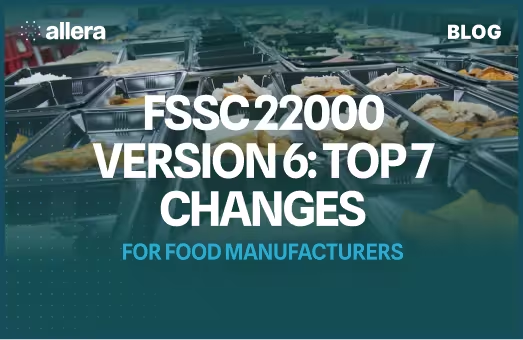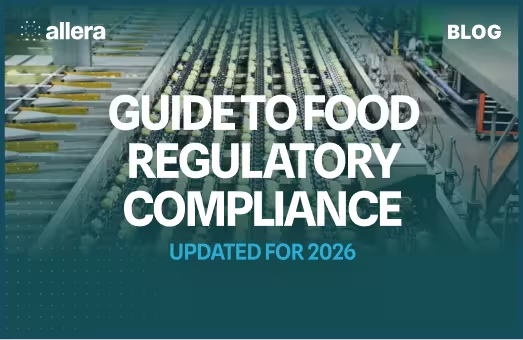

The 5 Best Meat Traceability Software Platforms of 2026
.avif)
When evaluating traceability software platforms, prioritize usability, integration, and compliance strength.
Look for food safety software systems that offer:
- End-to-end traceability from supplier to shipment.
- Automated document control with expiry reminders.
- AI compliance checks to flag SQF or FDA nonconformities.
- Audit-ready digital records accessible anytime.
- User-friendly design that ensures staff adoption.
- Integration flexibility into ERP and QA tools.
1. Allera
Allera is a leading compliance-first meat traceability platform focused on GFSI/FSMA 204 document control, supplier management, and instant recall readiness, offering strong AI-assisted compliance and digital recordkeeping with customizable forms.
Best For:
Small, medium, or large meat processors seeking to centralize supplier documentation, manage SOPs digitally, and ensure audit readiness across multiple facilities.
Key Features:
- Dynamic supplier onboarding and expiration tracking.

- AI-assisted compliance reviews aligned with SQF and FDA standards.
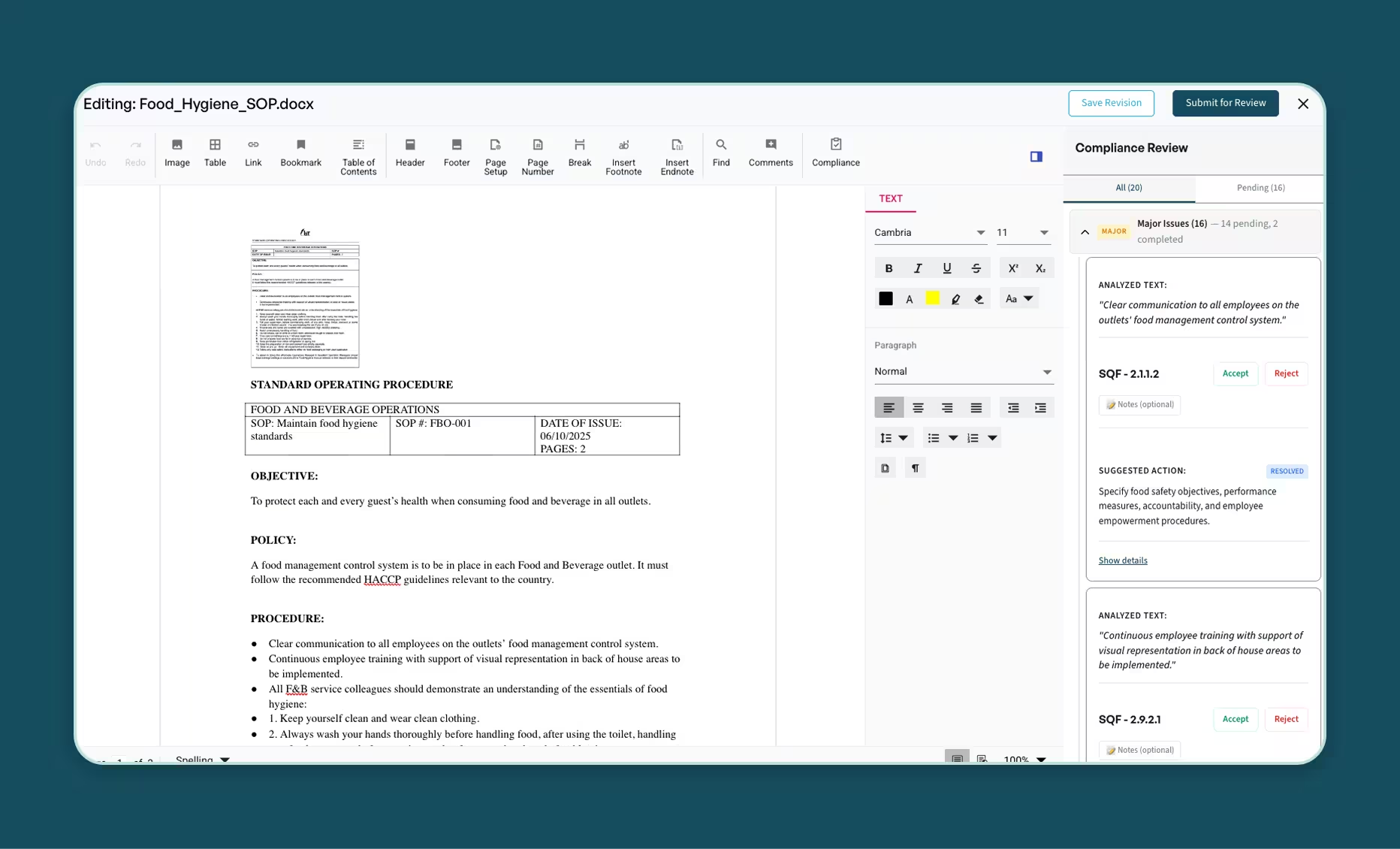
- Centralized SOP management and approval workflows.
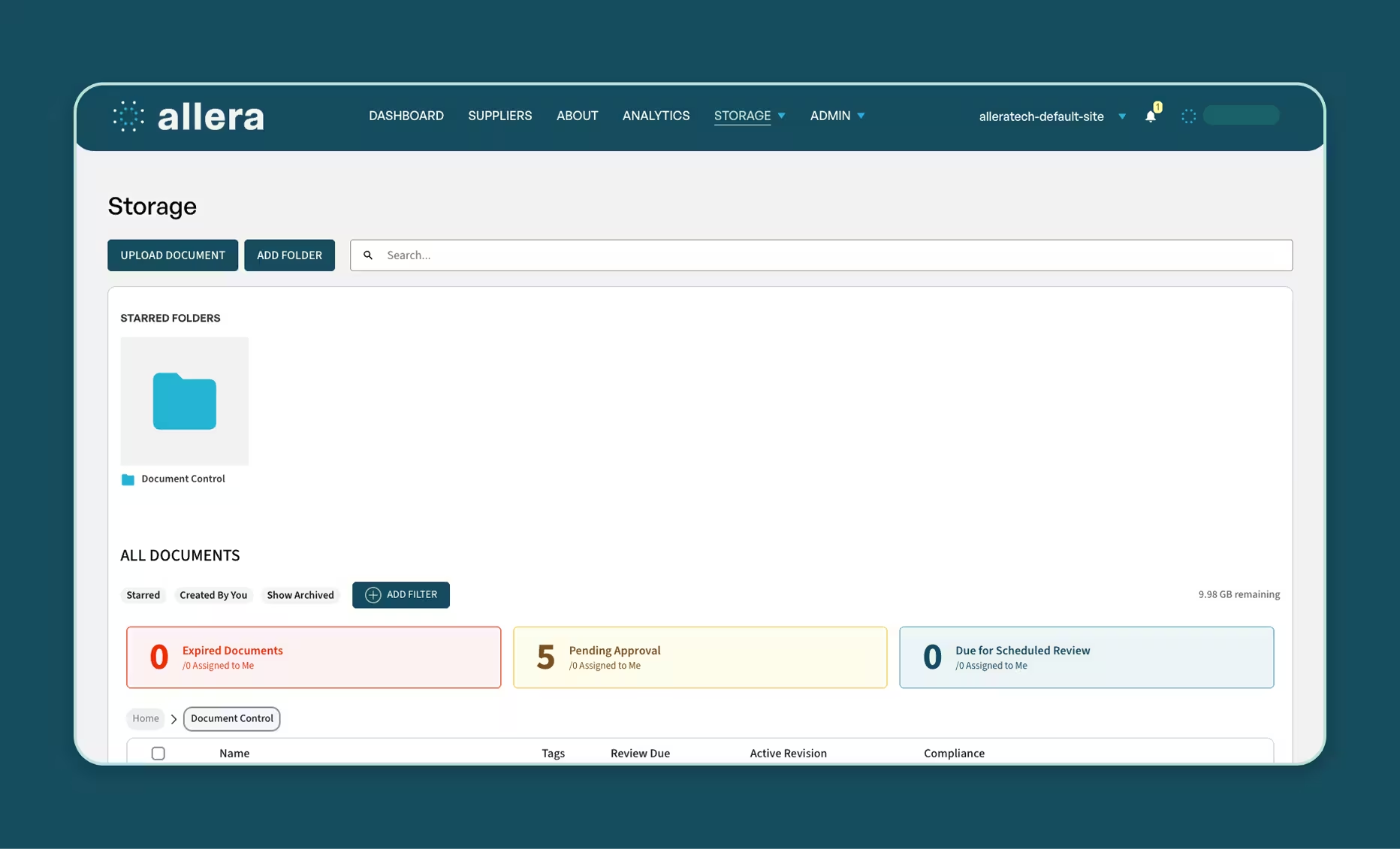
- Lot-level traceability from receiving to shipping.
- Automated audit preparation and searchability by lot code, product, and date.
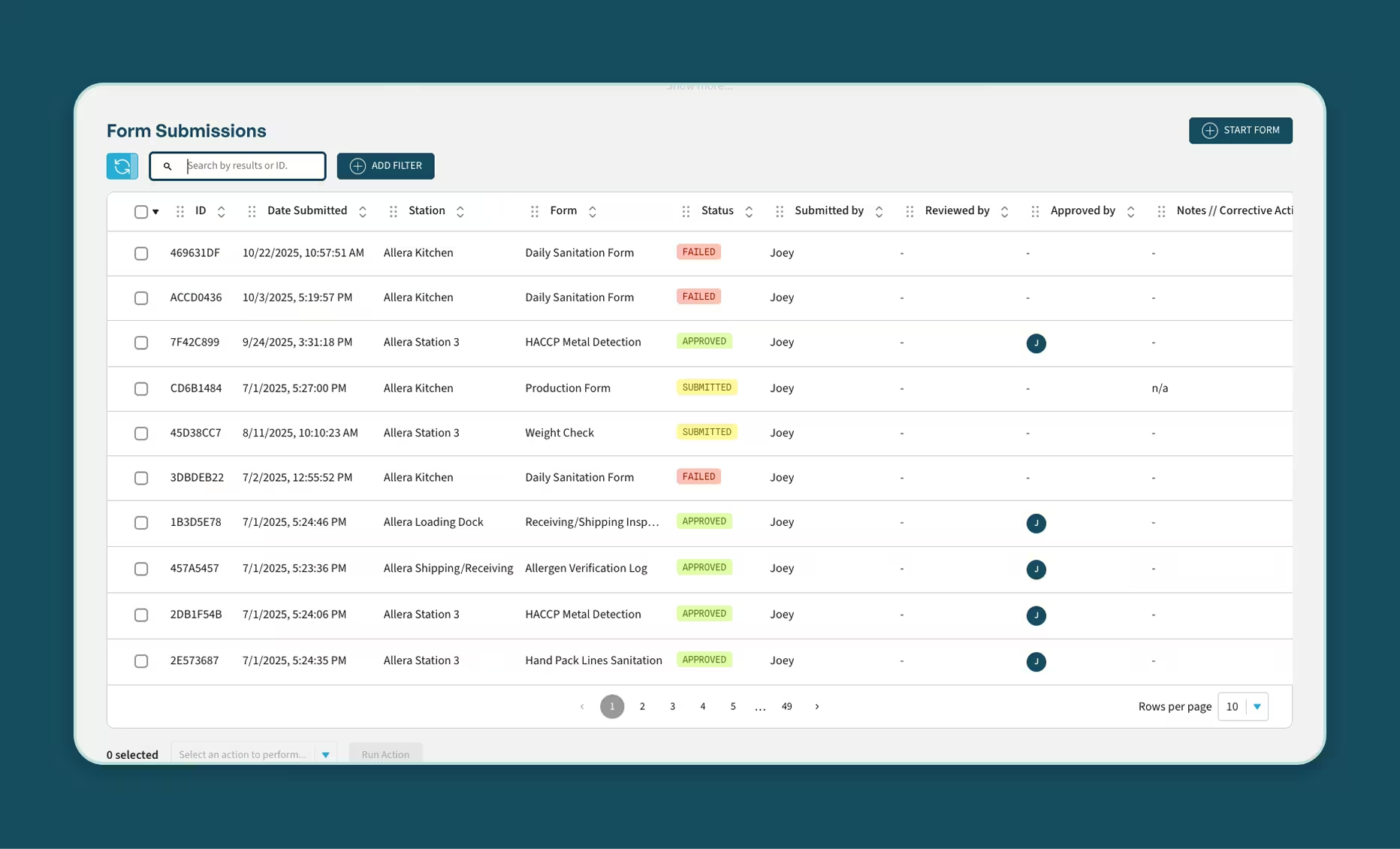
- Drag and drop customizable digital forms with real-time data capture.
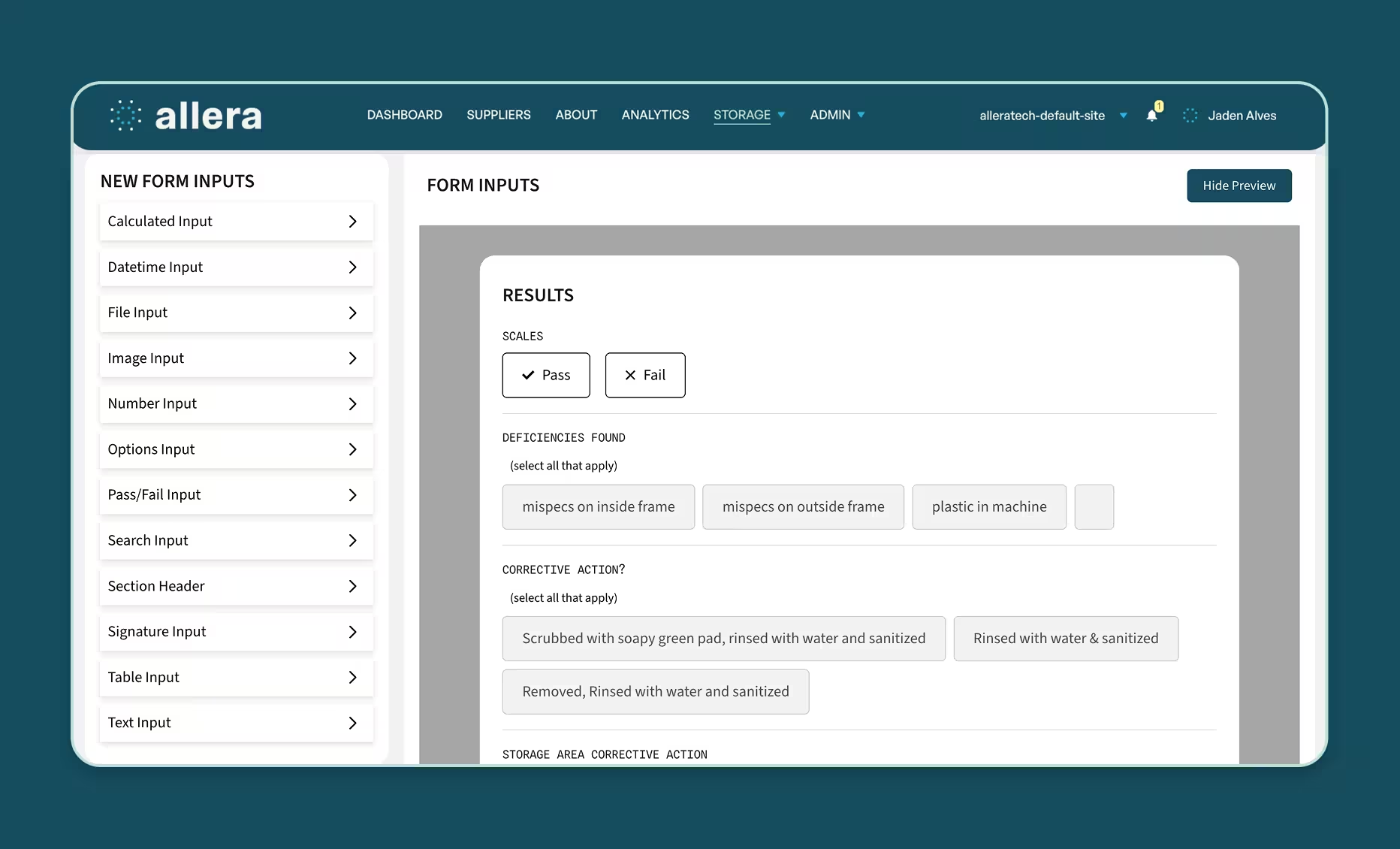
Pricing:
Contact for pricing.
Implementation Time:
Under 30 days for most deployments, with document digitization completed during onboarding.
Deployment Type:
Cloud-based with web and tablet accessibility, with no local installation required.
If your operation demands global visibility across supplier networks, the next solution—TraQtion—is worth considering.
2. TraQtion
Summary:
TraQtion is a cloud-based food safety and quality management platform developed by NSF International. It’s designed for enterprises that need end-to-end supply chain visibility, compliance automation, and performance analytics across multiple facilities or global markets.
Best For: Large, multinational meat producers or retailers requiring integrated oversight across sourcing, processing, and distribution.
Key Features:
- Global supply chain visibility with automated collection of supplier and production data.
- Supplier management and compliance verification dashboards.
- Corrective and Preventive Actions (CAPA) automation.
- Multi-language support for international operations.
- Recall management and trace-back functionality.
Pricing:
Contact vendor for specifics.
Implementation Time: 8–12 weeks on average due to the scale of data integration.
Deployment Type: Fully cloud-based platform, accessible on both desktop and mobile browsers, scalable for multinational operations.
While TraQtion is built for global enterprises, smaller plants needing detailed HACCP oversight will find Safefood 360° to be a strong, compliance-driven alternative.
3. Safefood 360°
Summary:
Safefood 360° is an enterprise-grade food safety and quality management system tailored to GFSI standards. It provides digital control of HACCP, supplier management, audits, and traceability—all in one platform trusted by some of the world’s largest food manufacturers.
Best For: Meat processors seeking an all-in-one platform to manage HACCP plans, GFSI programs, and supplier compliance simultaneously.
Key Features:
- HACCP plan builder and monitoring modules.
- Supplier approval workflows and audit management.
- Full traceability with recall simulation tools.
- GFSI, BRCGS, and SQF compliance management.
- Real-time performance dashboards for QA teams.
Pricing: Depends on modules and facility scale. Contact vendor.
Implementation Time: 6–10 weeks for typical implementations, though timelines depend on HACCP program complexity and organizational readiness.
Deployment Type: Cloud-based, accessible mainly via web browsers. iOS accessibility varies depending on system module.
For manufacturers looking for deeper ERP integration alongside traceability, JustFoodERP provides a unified operational and compliance platform.
4. JustFoodERP
JustFoodERP (powered by Microsoft Dynamics 365) is a complete enterprise resource planning solution built specifically for food and beverage manufacturers. It integrates financials, production, quality assurance, and lot traceability under one umbrella.
Best For: Mid-to-large meat processors who want their traceability data fully integrated with production and inventory management.
Key Features:
- End-to-end lot tracking from raw intake to customer shipment.
- Real-time production and inventory visibility.
- Built-in recall management workflows.
- FSMA and SQF compliance tracking.
- Supports integration with Microsoft Power BI for analytics and dashboards, but advanced analytics may require additional setup and customization.
Pricing: Contact for pricing.
Implementation Time: Typically 12–16 weeks, depending on ERP complexity and customization.
Deployment Type: Cloud-based via Microsoft Azure; accessible through desktop and mobile apps.
For smaller operations that want simple, affordable digital traceability without ERP overhead, Wherefour offers a user-friendly alternative.
5. Wherefour
Summary:
Wherefour is an intuitive, cloud-based inventory and traceability system built for small-to-mid food manufacturers. It simplifies compliance by digitizing production records, ingredient tracking, and batch-level data.
Best For: Smaller meat producers needing quick deployment and affordable compliance tools without sacrificing functionality.
Key Features:
- Batch and ingredient tracking for recall readiness.
- Expiration alerts and automatic lot numbering.
- Digital production logs and checklists.
- Inventory and cost-tracking integration.
- Quick setup with minimal IT requirements.
Pricing: Contact the vendor for current pricing; costs vary by configuration, plant size, and optional features.
Implementation Time: Typical setup and training take 2–4 weeks for small and mid-sized plants, but timing varies based on specific requirements.
Deployment Type: Cloud-based; accessible via desktop browser and mobile (iOS/Android).
Each of these platforms offers a distinct path toward traceability excellence — but the right choice depends on your plant size, compliance framework, and integration needs.
Meat Traceability Software Implementation Tips
Tips for Success
- Start with a pilot. Deploy in one department or facility before scaling.
- Train across roles. QA, operations, and supplier teams should understand their workflows.
- Automate validation. Use AI checks to flag data errors and expired documents.
- Define data owners. Assign accountability for supplier updates and record verification.
- Review performance. Track KPIs monthly to refine workflows and boost compliance accuracy.
Common Pitfalls
- Skipping staff training.
- Delaying SOP alignment.
- Neglecting software customization to reflect facility processes.
Integration & Automation Insights
Modern meat traceability platforms are rapidly integrating with IoT sensors, blockchain networks, and AI systems to strengthen visibility and compliance automation.
- IoT Devices: Automate temperature and process data collection from plant equipment.
- Blockchain: Provides immutable transaction logs for export certification and transparency.
- AI Compliance Tools: Detect nonconformances in real time, minimizing audit risks.
- Digital Labeling: Links labels to live traceability data for instant recall verification.
These technologies work together to build smarter, faster, and more reliable food safety systems.
Why Meat Traceability Software Is Necessary
The meat industry faces increasing pressure to demonstrate transparency and regulatory compliance. Manual tracking systems can no longer keep up with modern audit standards or rapid recall requirements.
Reasons it’s essential:
- Supports FSMA requirements and helps meet SQF and GFSI-benchmarked scheme expectations for traceability.
- Enables rapid recall and contamination response.
- Maintains supplier accountability through automated document control.
- Reduces audit preparation time with searchable digital records.
- Minimizes human error through automated data validation.
Without these tools, plants risk recall exposure, certification delays, and financial losses.
Industry Challenges & Trends in 2026
The global meat industry continues to evolve under regulatory pressure, market expansion, and technological disruption. In 2026, three key forces are shaping operational priorities: regulatory reform, workforce dynamics, and the digitization of compliance.
Key Challenges:
- Allergen Management: Labeling errors and undeclared allergens remain the top cause of meat recalls. FSQA teams must improve verification and label traceability to avoid costly incidents.
- Export Compliance: As global meat exports grow, plants must comply with overlapping regulations from the USDA, CFIA, and EU traceability standards.
- Labor Shortages: A persistent skills gap in quality assurance and production has accelerated the adoption of automation and AI-assisted data collection.
- Supply Chain Complexity: Increasing supplier networks require systems capable of consolidating data from multiple facilities and regions.
Emerging Regulatory Trends:
- FSMA 204 Final Rule: Requires covered foods on the FDA’s Food Traceability List to maintain specified records and be able to provide an electronic, sortable spreadsheet within 24 hours upon request.
- GFSI Benchmarking Changes: Greater scrutiny on supplier verification, digital recordkeeping, and traceability integration.
- Digital Documentation Emphasis: Agencies like the FDA and FSIS are increasingly encouraging electronic documentation to accelerate recall readiness.
According to the FDA’s Food Traceability Final Rule, by January 20, 2026, covered entities must be able to provide required key data elements in an electronic, sortable spreadsheet within 24 hours of a request. The USDA FSIS Recall Report highlight undeclared allergens and misbranding as leading recall causes.
These trends are pushing manufacturers to adopt AI, blockchain, and IoT-integrated traceability tools that ensure data integrity, supplier accountability, and automated compliance verification.
What's Next?
The right traceability software can make the difference between a recall and a resolved issue. From Allera’s AI-backed compliance tools to TraQtion’s global oversight and Wherefour’s agile deployment, each platform serves a unique segment of the industry.
For meat processors serious about compliance and efficiency, Allera stands out as the most balanced, audit-ready, and user-friendly option for 2026. However, always review and research multiple platforms. There is no one-size-fits-all.




.avif)

.avif)

.avif)
